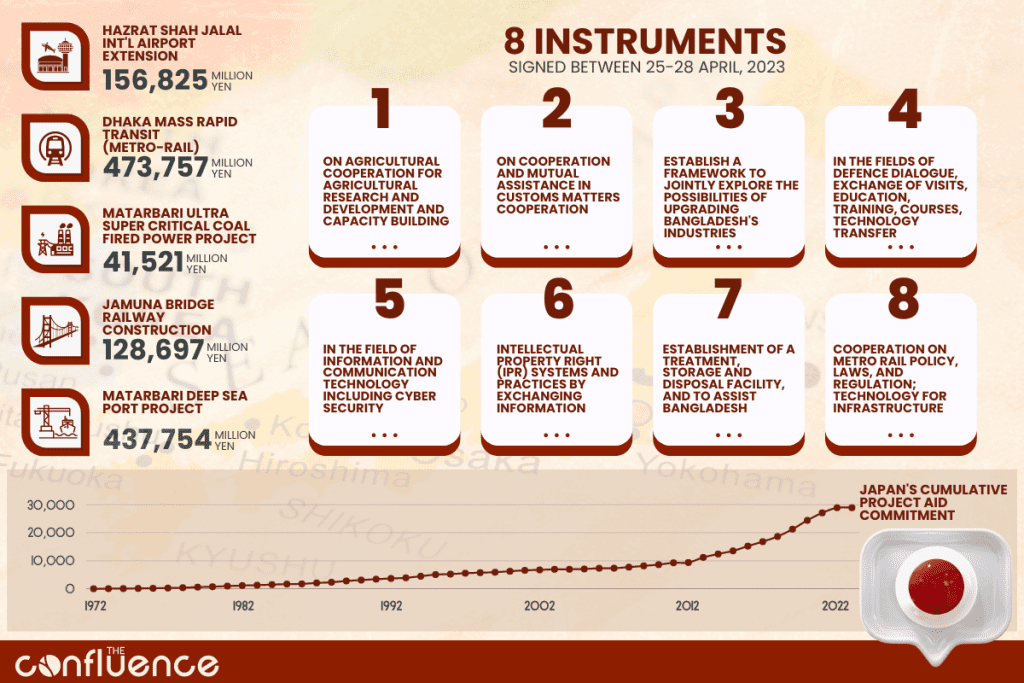Bangladesh-Japan economic partnership has reached a new height with Japan being the largest bilateral development partner of Bangladesh. Recently, during Prime Minister Sheikh Hasina’s visit to Japan, the two countries have signed 8 agreements.
Instruments signed during prime minister’s visit to japan
Agricultural Cooperation
Customs
Industrial Upgrading
Defence
Metro Rail
Ship Recycling
Intellectual Property Right
ICT
Bangladesh and Japan are set to sign the Economic Partnership Agreement (EPA) to bolster bilateral trade and investment between the two nations. The bilateral relationship between the two nations has grown rapidly over the years, and Japan is now one of our most significant strategic partners. The relationship between the two nations underwent a significant shift which saw the visit of Prime Minister Sheikh Hasina to Japan in April. This visit helped both countries to elevate their bilateral relationship from a comprehensive partnership to a “strategic” one. Currently, lots of Japanese corporations want to relocate operations to various regions of Asia, this would be a huge opportunity for Bangladesh to attract more investment from Japan. Bangladesh received more than $100 million in investment from Japan in 2022, a record high, as the number of Japanese enterprises in the nation quadrupled over the prior decade. Furthermore, Japan has developed as an important economic partner for Bangladesh, with the principal exports being ready-made clothing and leather items.
Bangladesh Exports to Japan (Million US$)
Source: EPB
No Data Found
However, there remains untapped potential for medicinal, agricultural, and fisheries goods to be exported to Japan. Bangladesh imports iron, steel, automobiles, and machinery from Japan at the same time. Addressing the current trade imbalance and growing trade prospects will be critical for the two nations’ long-term alliance. Tariff and duty structures, trade in products and services, investment, mutual recognition of certificates, and the present market condition all need to be examined. Against such a backdrop, the EPA demonstrates a strong commitment from both governments to deepen their economic collaboration and can serve as a model for other countries seeking similar accords for mutual growth and development.
A New Turning Point in Bangladesh-Japan Relations?
Japan is a developed country and a member of the G-7, with one of the most stable economies in the world. In fiscal year 2014-15, Bangladesh’s export revenues topped $1 billion for the first time in Asia. Bangladesh exported items worth $2 billion to Japan last fiscal year, representing a year-on-year increase of more than 40%. The clothing industry performed admirably in this regard, accounting for more than 95 percent of total exports. Garment exports to Japan increased by more than 45 percent yearly, reaching $1.59 billion in fiscal year 2022-23. Bangladesh’s exports to Japan have been increasing since 2008. Many Japanese corporations, particularly clothes shops, and brands, have begun to arrive in Bangladesh with large work orders. The Japanese government also eased the Rules of Origin for the knitwear industry in April 2011, which finally helped to raise garment shipments to Japan.
Major Export Categories to Japan (USD) for FY 2021-22
Souce: EPB
No Data Found
The Bangladesh-Japan Economic Partnership ushers in a new age of economic development and collaboration in the area, establishing a positive example for other nations. The visit of Prime Minister Sheikh Hasina to Japan laid the groundwork for robust economic relations between these two countries. Over the last decade, Japan has been watching Bangladesh for signing an EPA to increase economic interaction, and both nations are earnest in this respect. Because of its diverse product basket, Japan can easily supply at least 15 items for export. The EPA is wider than a free trade agreement (FTA) since it involves investment and services as well as tariff regimes. The first round of negotiations on the research took place in Tokyo in April, during Prime Minister Sheikh Hasina’s visit.
Net FDI Inflow from Japan (In Million USD)
Yearly net inflow since 1997
No Data Found
If an EPA can be struck with Japan, Bangladesh will profit greatly. The advantages will be realized in different areas, one of which is an increase in the inflow of foreign direct investment (FDI). Furthermore, because Japan is advanced in this field, Bangladesh will gain from the transfer of technological expertise from Japan. Bangladesh should seek additional FDI from Japan while also diversifying its export items, as the country’s export basket remains low in comparison to Japan. Bangladesh would lose $7 billion in commerce each year as it becomes a developing country due to the degradation of preferential duty benefits. If an EPA is not struck to maintain existing zero-duty privileges to Japanese markets, Bangladesh may incur duties ranging from 8% to 10% on commodities shipped to Japan after graduation.
Japanese FDI stock to Bangladesh by major sectors
In Million USD
No Data Found
How It Can Create a Win-Win Situation?
During the visit of Prime Minister Sheikh Hasina to Japan, both countries signed three memorandums of agreement to strengthen bilateral relations. The EPA, which is expected to be signed by the end of 2025 or early 2026, corresponds with Bangladesh’s desire to maintain duty-free export benefits after exiting the group of least-developed nations (LDCs) in 2026. The EPA between Bangladesh and Japan has the potential to benefit both countries.
Bangladesh has a lot of potential in terms of supply chain diversification and developing high-quality human resources. The new economic component will be beneficial to both countries. Japan has long been a development partner of Bangladesh, and it has invested in megaprojects and is eager to contribute more to help us become a Smart Bangladesh by 2041. Japan, on the other side, can profit from increased access to Bangladesh’s competitive garment and leather sectors, therefore promoting trade and economic growth. All restrictions will be removed under the EPA so that Japanese enterprises may spend more and show greater interest in the country’s economic growth. Japan has also shown an interest in providing duty-free trade facilities to Bangladesh throughout the post-graduation phase of Bangladesh.
For Bangladesh, the EPA can open the door to the enormous Japanese market for medicines, agricultural, and fisheries goods, enabling export diversification and trade imbalance reduction. Improved economic connections with Japan can also attract more foreign investment, therefore encouraging industrial output and fostering economic growth. The EPA wants to take this collaboration to new heights by resolving challenges that Japanese investors encounter and fostering a climate that encourages international investment and industrial output. Thus, the deal benefits both nations, with Bangladesh receiving access to the Japanese market for varied exports and Japan finding possibilities to engage in megaprojects and develop commerce.
In light of the EPA, Japanese investors’ issues will also be resolved. This will boost foreign investment and industrial output. Nishimura Yasutoshi, Japan’s Minister of Economy, Trade, and Industry, pledged full support to Bangladesh’s endeavor to become a high-income nation by 2041 during a meeting with State Minister for Foreign Affairs Md Shahriar Alam. Japan is now researching the favorable treatment that Bangladesh might receive following graduating from a middle-income nation. In this context, the EPA might be mutually beneficial for both nations.
About the Authors

Saume Saptaparna Nath is a Research Associate at The KRF Center for Bangladesh and Global Affairs (CBGA), completed post graduate studies from the Department of International Relations, University of Dhaka.

Muhammad Estiak Hussain is a Research Assistant at The KRF Center for Bangladesh and Global Affairs (CBGA).

